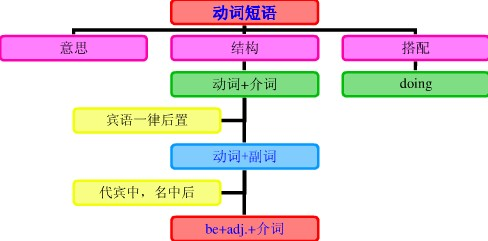本试题 “— ______ are you going to _____ it?— Keep it, of course.[ ]A. What, deal withB. How, deal withC. How, do withD. What, use” 主要考查您对动词短语
特殊疑问句
等考点的理解。关于这些考点您可以点击下面的选项卡查看详细档案。
- 动词短语
- 特殊疑问句
动词短语的概念:
动词常和某些其他词类用在一起,构成固定词组,形成所谓短语动词(phrasalverb)。和动词一样,短语动词也可分为及物和不及物两种。短语动词可以作为一个整体看待,同一般动词一样使用。
动词短语的搭配类型:
1)动词+介词:这类短语动词用作及物动词,后面须跟宾语。
如:The small boy insisted on going with his parents. 那男孩坚持要跟父母一起去。
Do you often listen to broadcasts in English? 你常听英语广播吗?
Look at the children. Aren't they lovely? 看着这些孩子们。他们多么可爱呀!
We stand for self-reliance. 我们是主张自力更生的。
这一类的短语动词还有很多,如depend on(upon)(依靠),wait on(服侍),look for(寻找),deal with(对待),look after(照料),wait for(等待)等。
2)动词+副词:
这类短语动词有的用作及物动词,有的用作不及物动词。
如:I always get up as soon as the bell rings. 我总是一打铃就起床。(不及物)
Look out, there's a car coming! 当心,来汽车了!(不及物)
Have you handed in your exercises already? 你已经交练习了吗?(及物)
Please don't forget to put on your coat, it's cold outside. 请不要忘记穿外衣,外面很冷。(及物)
这一类的短语动词还有很多,及物如put out(扑灭),eat up(吃光),put down(放下);不及物如set off(出发),come up(走近),go on(继续)。
注:"动词+副词"这类短语动词和上面第一类"动词+介词"的不同之处在于:"动词+介词"用作及物动词,后面须跟宾语。"动词+副词"则有的及物,有的不及物;用作及物动词而宾语为人称代词或自身代词时,副词往往放在宾语之后。
如:Please wake me up at five tomorrow. 请在明天早上五点唤醒我。
If you have done your exercises, please hand them in. 如果你们练习做完了请交来。
She doesn't normally behave like that, she's putting it on. 她通常并不如此表现,她是装出来的。
注:这类短语动词有不少可兼作及物和不及物动词用。
如:He took off his hat when he entered the office. 他进办公室后脱下帽子。(及物)
The plane took off at seven sharp. 飞机在七点整起飞。(不及物)
Charlie rang up Neil to ask about the time of the meeting. 查理打电话给尼尔问开会的时间。(及物)
If you can't come, please ring up and let us know. 你如来不了,请来电话告诉我们一声。(不及物)
3)动词+副词+介词:
"动词+副词"之后有的可以再加一个介词,形成另一种短语动词。这类短语动词用作及物动词。
如:Do not give up hope. We must go on with the experiment 不要失望。我们必须继续试验。(go on with继续)
He came up to me. 他走到我跟前。(come up to走近)
这类短语动词还有:look down upon(看不起),do away with(去掉),put up with(忍受)等。
4)动词+名词+介词:
这类短语动词也是及物的。
如:He shook hands with all the guests at the banquet. 他在宴会上和宾客一一握手。
Young pioneers often come to the Children's Palace to take part in after school activities.少先队员经常到少年宫来参加课外活动。
Pay attention to the temperature of the stored rice. 注意仓库里的稻谷的温度。
Her job is taking care of the babies. 她的工作是照顾婴儿。
这一类短语动词还有:put an end to(结束),take notice of(注意),catch hold of(抓住),lose sight of(看不见),make use of(利用)等。
动词短语知识体系:

特殊疑问句的概念:
就句中某一部分进行提问的疑问句叫做特殊疑问句。特殊疑问句的基本结构是“疑问词+一般疑问句”,其回答应当是具体的。特殊疑问句句末一般用降调。
例如:How do I get there?
Why not?
What about the sports news?
特殊疑问句的使用:
1、特殊疑问句的概念: 所谓特殊疑问句就是指以疑问词开头的疑问句。
如:What are you laughing at? 你们笑什么? 句中的what就是疑问词,它的意思是“什么”。
英语中的疑问词不多,常见的有what, who, whose, when, where, why, how等;
以how开头的how many, how much, how old等,以及以what开头的what colour, what year, what class等,也都可视为疑问句。
如:How many do you need? 你们需要多少?
What colour are your curtains? 你的窗帘是什么颜色的?
2、特殊疑问句的两种句型:
特殊疑问句有两种句型结构,一种是“疑问词+一般疑问句”。
如:When did you see him? 你什么时候见到他的?
Why are you late again? 你怎么又迟到了。
第一句中的when为疑问词,其后的did you see him为一般疑问句形式;
第二句中的why为疑问词,are you late again是一个一般疑问句。
另一种是“疑问词+陈述句语序”,此时的疑问词在句中用作主语,或是修饰主语。
如:Who can answer this question? 谁能回答这个问题?
Which book is more cheap? 哪本书更便宜些?
第一句中的who为疑问词,在句中用作主语,整个句子为陈述句词序;
第二句中的which为疑问词,在句中修饰主语book,整个句子也是陈述句词序。
3、特殊疑问句的回答:
特殊疑问句与一般疑问句不同,它不能直接用Yes或No来回答,而应根据具体情况作出相应的回答。
如:—Who sings best? 谁唱得最好?
—(误)Yes, he does.
—(正)Tom does. 汤姆唱得最好。
4、特殊疑问句的省略形式:
特殊疑问句有时可用省略形式,尤其是省略与前面相同的句子结构。
如:—He won't come. 他不来了。
—Why? 为什么?
—There's someone coming. 有人要来。
—Who? 谁?
有些省略形式已成为约定成俗的固定表达,请大家要引起注意噢!
如:Why not use both? 为什么不两者都用?
What about having a rest? 休息一会儿怎么样?
Why not…后接动词原形,表示建议,意为“为什么不……呢”;
What about…后接名词或动名词,也表示建议,意为“……怎么样”。
使用特殊疑问句特别提示:
1、疑问词的选用:
特殊疑问句是以what, who, when, where, how等开头的疑问句。这些表示疑问的词叫做疑问词。当然提问的内容的不同,我们使用的疑问词也不同。问物或做什么事用what,问电话号码也用what;问人的用who;问谁的用whose;问哪里用where;问何时用when;问年龄用how old;问身高用how tall;问颜色用what colour等。
例如:—What colour is your sweater? 你的毛衣是什么颜色的?
—It's blue. 蓝色。
—Whereisyourfather? 你的爸爸在哪?
—He's in the kitchen. 他在厨房。
2、语序:
想知道对方是谁,汉语中可问“你是谁?”译成英语时语序变了,成了“Who are you?”而不能是“You are who?”所以,在英语中,我们特殊疑问句一般用倒装的语序,即用“特殊疑问词+一般疑问句的语序”构成。
小贴士:如果疑问词在句中作主语,则其后直接跟动词,语序不变。
例如:Who is going to the park tomorrow? 明天谁要去公园?
3、回答:
回答一般疑问句用yes和no来回答。但回答我们特殊疑问句时不可以用yes或no来回答,而应根据所提问的内容直接做出回答。
例如:—How tall are you? 你多高?
—I'm 1.7 meters tall. 我1.7米高。
—How is your brother? 你弟弟好吗?
—He's fine. 他很好。
—Thanks 谢谢。
小贴士:问句中的名词在答语中常用代词来代替,如上句中的yourbrother由he来代替。一般来说,this和that指物常用it来代替;these和those指物或人时可以用they代替。
如:What's this? It's a book.
What are these? They are books.
4、语调:
一般疑问句在朗读时应用升调,选择疑问句先升后降,而我们特殊疑问句在朗读时则用降调。
与“— ______ are you going to _____ it?— Keep it, of course.[...”考查相似的试题有:
- --- Did you hear someone talking in the living room?--- Oh, I forgot to ____ the TV just now.A.switch offB.switch o...
- Though these dresses are low in quality, they may to women who don’t want to spend much on clothes.A.referB.adjustC...
- The idea of cloning extinct dinosaurs _____ a mixture of fear and excitement into people’s hearts, as evidenced by th...
- The twins were so _______ in their TV play that neither of them heard the door ring.A. adapted B occupied C absorbed ...
- Nowadays,it's considered acceptable for a couple to________if the marriage doesn't bring themhappiness.[ ]A. make upB...
- With the electricity __________, people use candles instead.[ ]A. cut offB. cut inC. cut awayD. cut down
- The professor spoke so fast during the lecture that we couldn’t _____ what he said.A.turn outB.make outC.carry out...
- He’s obviously quite embarrassed about it so he ____ me to tell anyone.A.preventedB.owedC.permittedD.forbade
- We have to ___the wheat as soon as possible because a storm is on the wayA.get awayB.get acrossC.get throughD.get in
- Why __________ put the meat in the fridge? It'll stay fresh for several days.[ ]A. notB. not youC. youD. do you